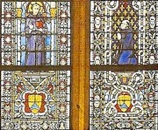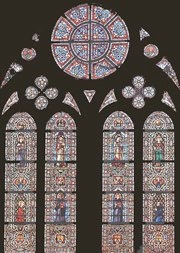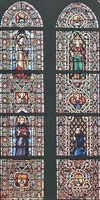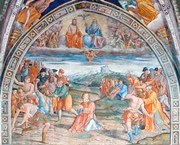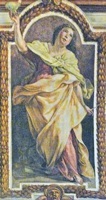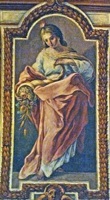Cardinal Gentile Partino da Montefiore
with his arms depicted below
The list of burials of 1509 says that Cardinal Gentile Partino da Montefiore built the Cappella di SS Antonio e Ludovico and that he was buried here when he died in 1312, presumably because “his” Cappella di San Martino on the opposite side of the nave was not completed by that time. Brother Ludovico da Pietralunga (referenced below) recorded the presence of the tomb of Cardinal Gentile in the pavement in front of the altar. The remains of Cardinal Gentile were recovered when the chapel was remodelled in 1763, and no trace of the tomb now survives. (The association of Cardinal Gentile with San Francesco is described in the page on San Francesco in the 14th Century).
The dedication given here to “SS Antonio e Ludovico” deserves comment:
-
✴The probability that this chapel was indeed originally dedicated in part to St Antony of Padua is increased by the fact that in the stained glass window (see below) depicts Cardinal Gentile kneeling before St Antony of Padua. If this is correct, then the dedication to St Antony of Padua subsequently passed to the adjacent chapel to the left.
-
✴Since the construction of chapel pre-dates the canonisation of St Louis of Toulouse by at least 5 years, the other part of the original dedication was probably (at least formally) to St Louis IX of France.
The chapel was documented as the Cappella di Santo Stefano in 1348 and 1359, but as the Cappella di San Ludovico in 1416. It was conceded to the Confraternita di San Gregorio and the Confraternita di Santo Stefano in 1535.
Stained Glass (ca. 1317)
The stained glass windows of the chapel are attributed to Giovanni di Bonino. The rose contains geometric designs, and the four lights below depict:
-
✴in the top register of all four, the symbols of the Evangelists;
-
✴in the panes below, on the left:
-
•St Louis of Toulouse dressed as Bishop of Toulouse, receiving the blessing of Christ ; and
-
•St Louis of Toulouse dressed as a layman, kneeling before St Francis;
-
✴in the panes below, on the right:
-
•the Virgin and St Louis IX of France; and
-
•Cardinal Gentile (identified as “D[ominus] Gentili[s]”) kneeling before St Antony of Padua; and
-
✴in the bottom register of all four, the arms of Cardinal Gentile.
The presence of a halo in the two depictions of St Louis of Toulouse suggest that the glass was designed in anticipation of his imminent canonisation, which occurred in 1317. The work was probably an Angevin commission, and it is entirely possible that the family worked closely with the (unknown) executors of Cardinal Gentile. (The wider subject of Angevin patronage in San Francesco is described in the page on San Francesco in the 14th Century).
Frescoes
Scenes from the Life of St Stephen (1575)
The Confraternita di Santo Stefano commissioned these frescoes from Dono Doni. The friars, who made a donation of 60 florins, imposed the condition that the work should include a figure of St Louis of Toulouse, in order preserve the original dedication of the chapel and the memory of Cardinal Gentile Partino.
Dono Doni died in the following year and the work was completed by his workshop. The scenes, which are in the lunettes and read from right to left, depict:
-
✴St Stephen disputing with the doctors in the synagogue;
-
✴St Stephen expelled from Jerusalem; and
-
✴the stoning of St Stephen (illustrated here).
The figure of St Louis of Toulouse was never executed.
Prophets and Sibyls (1575)
These frescoes in the vaults are also by Dono Doni.
Charity and Prudence (1659)
These frescoes to the sides of the entrance arch are by Giacomo Giorgetti.
Art from the Cappella di San Ludovico
Gonfalone della Peste (ca. 1470)
This processional banner was first documented by Giorgio Vasari (in 1568) and by Fra. Ludovico da Pietralunga (in ca. 1575 - referenced below), when it served as the altarpiece in this chapel. Both authors (who had probably discussed the matter) attributed it to Nicolò di Liberatore, l' Alunno, and both comment that it was taken in procession at times of plague.
The chapel had belonged to two confraternities, the Confraternita di Santo Stefano and that of San Gregorio, since 1535, and it seems likely that the banner had previously belonged to one of them (The Confraternita di San Gregorio owned another banner by Nicolò di Liberatore, which is described on the page on this artist). The banner from San Francesco was sold in the 19th century and is now in the Priesterhaus, Kevelaer (in northern Germany).
The banner depicts:
-
✴Christ in majesty, in the upper part of the composition; and
-
✴SS Sebastian, Clare, Francis, Rufinus, Victorinus and Roch and (in the middle register) the Virgin, all of whom plead with Christ to spare the city from the plague.
It is illustrated in black and white in the website of the Fondazione Federico Zeri.
The composition involves a fine cityscape of Assisi, which helps to date it: it shows the Rocca in the form that it took in 1460; but it omits the scarp wall of the infirmary of the Sacro Convento, which was built in 1472.
Read more:
P. Scarpellini, “Fra Ludovico da Pietralunga: Descrizione della Basilica di San Francesco d’ Assisi”, (1982), Treviso
Return to the page on Chapels in the Lower Church.
Return to the main page on San Francesco.
Return to Walk III.
Return to the home page on Assisi.


